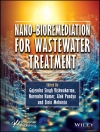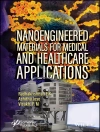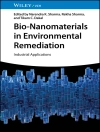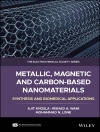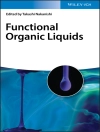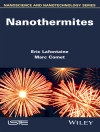Tailored Functional Oxide Nanomaterials
A comprehensive exploration of the preparation and application of metal oxide nanomaterials
Tailored Functional Oxide Nanomaterials: From Design to Multi-Purpose Applications delivers a one-of-a-kind discussion of the fundamentals and key applications of metal oxide nanomaterials. The book explores everything from their preparation to the mastering of their characteristics in an interdisciplinary view. The distinguished authors address theoretical research and advanced technological utilizations, illustrating key issues for the understanding and real-world end-uses of the most important class of inorganic materials.
The interplay between the design, preparation, chemico-physical characterization, and functional behaviors of metal oxide nanomaterials in a variety of fields is presented. Up-to-date work and knowledge on these materials is also described, with fulsome summaries of important applications that are relevant to researchers pursuing safety, sustainability, and energy end-uses.
Readers will also find:
- A thorough introduction to vapor phase growth of metal oxide thin films and nanostructures
- Comprehensive explorations of addressing complex transition metal oxides at the nanoscale, including bottom-up syntheses of nano-objects and properties
- Practical discussions of nanosized oxides supported on mats of carbon nanotubes, including synthesis strategies and performances of Ti/CNT systems
- In-depth examinations of computational approaches to the study of oxide nanomaterials and nanoporous oxides
Perfect for materials scientists, inorganic chemists, physicists, catalytic chemists, and chemical engineers, Tailored Functional Oxide Nanomaterials will also earn a place in the libraries of solid-state chemists.
Зміст
Preface xiii
1 Vapor Phase Growth of Metal-Oxide Thin Films and Nanostructures 1
Lynette Keeney and Ian M. Povey
1.1 Introduction to Vapor Phase Deposition 1
1.2 Vapor Phase Deposition Methodologies 1
1.2.1 Chemical Vapor Deposition 2
1.2.2 Atomic Layer Deposition 2
1.3 Precursors and Chemistry 3
1.4 Applications of Metal-Oxide Vapor Phase Deposition 4
1.4.1 Case Study 1: Ferroelectric Oxide Materials 4
1.4.1.1 Ferroic Thin Films 5
1.4.2 Case Study 2: Dielectric Oxide Materials 18
1.5 Conclusions 27
References 28
2 Addressing Complex Transition Metal Oxides at the Nanoscale: Bottom-Up Syntheses of Nano- objects and Properties 43
David Portehault, Francisco Gonell, and Isabel Gómez-Recio
2.1 Introduction 43
2.2 Multicationic Oxides 45
2.2.1 Layered Oxide-Based Materials 45
2.2.2 Oxidation States Stable in Organic Media: The Case of Perovskites 50
2.2.3 Oxidation States Poorly Stable in Organic Media: The Case of Perovskites 54
2.3 Oxides with Uncommon Metal Oxidation States: The Case of Titanium(III) in Oxides and Extension to Tungsten Oxides 58
2.3.1 Crystal Structures and Requirements for the Synthesis of Oxides Bearing Titanium(III) Species 59
2.3.2 Ti2O3 Nanostructures 61
2.3.3 Mixed Valence Ti(III)/Ti(IV) Oxides: Magnéli Phases 63
2.3.4 Comparison to Metal Oxidation States Stable in Organic Media: Mixed W(V)/W(VI) Oxides 68
2.4 Stabilization of New Crystal Structures at the Nanoscale 73
2.4.1 Hard Templating to Isolate Bulk Metastable Oxides at High Temperatures 74
2.4.2 Beyond Hard Templating for Isolating Nanostructures of Metastable Oxides 75
2.4.3 Colloidal Syntheses 75
2.5 Concluding Remarks 76
References 77
3 Nanosized Oxides Supported on Arrays of Carbon Nanotubes: Synthesis Strategies and Performances of Ti O2/CNT Systems 89
Maria Letizia Terranova and Emanuela Tamburri
3.1 Introduction 89
3.2 Synthesis Strategies for Preparation of CNT Arrays 90
3.3 Selected Examples of Supported Nano-oxides 91
3.4 A Focus on the Ti O2/CNT Systems 93
3.4.1 Synthesis of Ti O2 on CNT 99
3.4.1.1 Wet Chemistry 100
3.4.1.2 Vacuum Techniques 103
3.5 Concluding Remarks 107
References 108
4 Computational Approaches to the Study of Oxide Nanomaterials and Nanoporous Oxides 111
Ettore Fois and Gloria Tabacchi
4.1 Introduction 111
4.2 Overview of Theoretical Approaches 113
4.3 Molecular Behavior at Nanomaterials Surfaces 114
4.3.1 Molecular Interactions on Manganese Oxide Nanomaterials 114
4.3.2 Insight on Molecule-to-Material Conversion in Chemical Vapor Deposition 116
4.4 Oxide Porous Materials 121
4.4.1 Structural Properties 121
4.4.2 Behavior Under High-Pressure Conditions 124
4.4.3 Hybrid Microporous Functional Materials 127
4.5 Outlook and Perspectives 131
References 133
5 Functional Spinel Oxide Nanomaterials: Tailored Synthesis and Applications 137
Zheng Fu and Mark T. Swihart
5.1 Introduction and Topic Overview 137
5.2 Syntheses 138
5.2.1 Vapor Phase 138
5.2.1.1 Chemical Vapor Deposition 138
5.2.1.2 Atomic Layer Deposition 138
5.2.1.3 Spray Pyrolysis 140
5.2.1.4 Laser Pyrolysis 141
5.2.1.5 Plasma Methods 142
5.2.2 Solution Phase 143
5.2.2.1 Sol–Gel Methods 143
5.2.2.2 Hydrothermal Methods 143
5.2.2.3 Thermal Decomposition 143
5.2.2.4 Solvothermal Methods 145
5.2.3 Solid Phase 146
5.2.3.1 Solid-State Thermal Decomposition 146
5.2.3.2 Combustion 147
5.2.3.3 Ball Milling 148
5.2.3.4 High-Temperature Solid Solution Method 148
5.3 Structure–Effect Applications 150
5.3.1 One-Dimensional (1D) Structures 151
5.3.1.1 Nanorods 151
5.3.1.2 Nanowires 154
5.3.1.3 Nanotubes 154
5.3.2 Two-Dimensional (2D) Structures 159
5.3.2.1 Nanofilms 159
5.3.2.2 Nanosheets 159
5.3.2.3 Nanoplatelets 163
5.3.3 Three-Dimensional (3D) Structures 165
5.3.4 One- and Two-Dimensional (1&2D) Structure 170
5.3.5 One- and Three-Dimensional (1&3D) Structures 171
5.3.6 Two- and Three-Dimensional (2&3D) Structure 173
5.4 Self-Assembled Structures 175
5.5 Conclusions and Future Perspectives 180
References 184
6 Photoinduced Processes in Metal Oxide Nanomaterials 193
Nikolai V. Tkachenko and Ramsha Khan
6.1 Introduction 193
6.2 Photophysics of Bulk MOs 195
6.2.1 Energy-Level Structure and Steady-State Spectra 195
6.2.2 Photoexcitation and Relaxation Dynamics 201
6.2.3 Emission Decay Kinetics, Time-Resolved PL 203
6.2.4 Transient Absorption (TA) Spectroscopy 205
6.3 Nanostructures 208
6.3.1 Quantum Confinement 208
6.3.2 Surfaces and Interfaces 211
6.4 Photophysical Aspects of MO Applications 218
6.4.1 Solar Cells 218
6.4.2 Light Emitting Devices 219
6.4.3 Photocatalysis 219
6.4.4 Photodegradation 219
6.4.5 Solar Driven Chemistry 220
6.5 Conclusions 220
References 221
7 Metal Oxide Nanomaterials for Nitrogen Oxides Removal in Urban Environments 229
M. Cruz-Yusta, M. Sánchez, and L. Sánchez
7.1 Introduction: Photocatalytic Removal of Nitrogen Oxides Gases 229
7.2 Ti O2-Based Materials 230
7.2.1 Tailoring the Energy Band Gap and Edges’ Potentials 231
7.2.2 Dopant Elements and Quantum Dots 234
7.2.3 Defects, Vacancies, and Crystal Facets in the Ti O2 Nanostructure 235
7.2.4 Composites/Substrates 236
7.2.5 Titanium-Based Oxides 237
7.3 Alternative Advanced Photocatalysts 238
7.3.1 Bismuth Oxides 238
7.3.2 Tin- and Zinc-Based Oxides 242
7.3.3 Transition Metal Oxides 247
7.4 New Insights into the NOx Gases Photochemical Oxidation Mechanism 251
7.5 Field Studies in Urban Areas 253
7.5.1 Photocatalytic Construction Materials 253
7.5.2 Field Studies of NOx Abatement in Real Environments 254
7.6 Conclusions and Perspectives 256
References 259
8 Synthesis and Characterization of Oxide Photocatalysts for CO2 Reduction 277
Fernando Fresno and Patricia García-Muñoz
8.1 Introduction 277
8.2 Fundamentals of Heterogeneous Photocatalysis 279
8.3 Applications of Heterogeneous Photocatalysis 281
8.4 Photocatalytic CO2 Reduction: State of the Art and Main Current Issues 283
8.4.1 Ti O2-Based Photocatalysts for CO2 Reduction 286
8.4.2 Other Oxide Photocatalysts 291
8.5 Oxide-Based Heterojunctions and Z-Scheme Photocatalytic Systems 295
8.5.1 Cocatalysts for CO2 Reduction: Metal-Oxide Synergies 299
8.6 Conclusions and Future Perspectives 303
References 303
9 Functionalized Titania Coatings for Photocatalytic Air and Water Cleaning 317
Ksenija Maver, Andra? Šuligoj, Urška Lavrenˇciˇc Štangar, and Nataša Novak Tušar
9.1 Introduction 317
9.1.1 Titania as a Photocatalyst for Air and Water Cleaning 317
9.1.2 Titania Functionalization 319
9.1.3 Fabrication of Titania-Based Coatings 320
9.1.4 Characterization of Titania-Based Materials 321
9.2 Case Studies 323
9.2.1 Si O2-Supported Ti O2 for Removal of Volatile Organic Pollutants from Indoor Air Under UV Light 323
9.2.2 Sn-Functionalized Ti O2 as a Photocatalytic Thin Coating for Removal of Organic Pollutants from Water Under UV Light 325
9.2.3 Si O2-Supported Ti O2 Functionalized with Transition Metals for Removal of Organic Pollutants from Water Under Visible Light 329
9.3 Conclusion and Further Outlook 335
References 335
10 Metal Oxides for Photoelectrochemical Fuel Production 339
Gian Andrea Rizzi and Leonardo Girardi
10.1 Introduction to Photoelectrochemical Cells 339
10.1.1 The Photoelectrochemistry Approach 344
10.2 Metal Oxides Photoelectrode Candidate Materials 347
10.2.1 Photoanodes 349
10.2.2 Photocathodes 349
10.3 Tailoring Surface Catalytic Sites and Catalyst Use 350
10.4 Metal Oxide Heterostructures 353
10.5 Metal Oxides as a Protective Anti-corrosion Layer in Photoelectrodes 354
10.6 Evaluation of Photoelectrode Efficiencies 359
10.7 Conclusions and Perspectives 365
References 367
11 Tailoring Porous Electrode Structures by Materials Chemistry and 3D Printing for Electrochemical Energy Storage 379
Sally O’Hanlon and Colm O’Dwyer
11.1 Strategies for Functional Porosity in Electrochemical Systems 379
11.2 Benefits and Limitations of Structural Engineering for Electrochemical Performance 382
11.3 Tailoring the Pore Structure of Metal Oxides for Li-ion Battery Cathodes and Anodes 383
11.4 Developments in 3D Printing of Porous Electrodes for Electrochemical Energy Storage 389
11.5 Porous Current Collectors by 3D Printing 390
11.6 Battery and Supercapacitor Materials from 3D Printing 392
11.7 Conclusions and Outlook 394
References 396
12 Ferroic Transition Metal Oxide Nano-heterostructures: From Fundamentals to Applications 405
G. Varvaro, A. Omelyanchik, and D. Peddis
12.1 Introduction 405
12.2 Ferroic Properties of Complex Transition Metal Oxides 408
12.2.1 Spinel Ferrites 408
12.2.2 Perovskites 411
12.2.3 Other Magnetic Oxides 412
12.3 Magnetic Oxide Heterostructures 413
12.3.1 Hard/Soft Exchange-Coupled Systems 413
12.3.2 Ferro(i)magnetic/Antiferromagnetic Systems 416
12.3.3 All-Oxide Synthetic Antiferromagnets 419
12.4 Artificial Multiferroic Oxide Heterostructures 421
12.4.1 Strain Transfer Mechanism 423
12.4.2 Charge Modulation Mechanism 426
12.4.3 Exchange Interaction Mechanism 427
12.5 All-Oxide Spintronic Heterostructures 427
12.6 Conclusion and Perspectives 430
References 431
13 Metal-Oxide Nanomaterials for Gas-Sensing Applications 439
Pritamkumar V. Shinde, Nanasaheb M. Shinde, Shoyebmohamad F. Shaikh, and Rajaram S. Mane
13.1 Introduction 439
13.2 Types of Gas Sensors 442
13.3 Metal-Oxide Nanomaterial-Based Gas Sensors 443
13.4 Preparation of Metal-Oxide Gas Sensors 446
13.4.1 Operation Mechanism 446
13.4.2 Morphology-Related Structural Parameters 448
13.4.2.1 Grain Size 448
13.4.2.2 Pore Size 449
13.4.3 Crystallographic Defective and Heterointerface Structures 453
13.4.3.1 Defect Structure 453
13.4.3.2 Heterointerface Structure 455
13.4.4 Chemical Composition 458
13.4.5 Addition of Noble Metal Particles 458
13.4.6 Humidity and Temperature 461
13.5 Gas-Sensing Mechanisms 462
13.5.1 Adsorption/Desorption Model 462
13.5.1.1 Oxygen Adsorption Model 464
13.5.1.2 Chemical Adsorption/Desorption 467
13.5.1.3 Physical Adsorption/Desorption 470
13.5.2 Bulk Resistance Control Mechanism 471
13.5.3 Gas Diffusion Control Mechanism 472
13.6 Conclusions and Future Perspectives 474
References 475
Index 487
Про автора
Chiara Maccato, Ph D, is Professor of Inorganic Materials and Nanosystems and General and Inorganic Chemistry at Padova University, Italy. She is the coordinator of a morphological characterization laboratory and responsible for a research group on multi-functional inorganic nanomaterials.
Davide Barreca, Ph D, is Research Director at CNR-ICMATE, Italy, and member of the International EUROCVD Board. His research activity is focused on multi-functional metal-oxide nanosystems, from thin films to ordered nano-arrays, for applications in sensing, energetics and photocatalysis.


